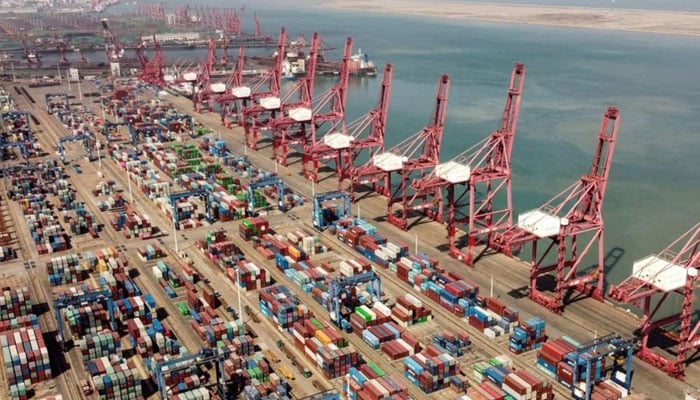Modernization in China
The 20th National Congress of the Communist Party of China (CPC) has proposed advancing the progress of the Chinese nation on all fronts through a Chinese path to modernization. In this context, the people of China embark on a new journey towards building their country into a modern socialist country in all respects.
The success in Chinese modernization was neither handed down from the heavens nor emerged by itself. It has been attained step by step through determined, painstaking efforts of the Chinese people under the leadership of the CPC which has always stayed true to its founding mission.
After the Opium War in the mid-nineteenth century, China was plunged into the darkness of domestic turmoil and foreign aggression; its people, ravaged by war, saw their homeland torn apart and lived in poverty and despair. They were, at that moment, asking: where is our hope and future?
Since its founding more than one hundred years ago, the CPC has righteously taken up the historical mission of achieving the great rejuvenation of the Chinese nation. The party has united and led China’s people to carry out a hard struggle, and embarked on the great journey of independently building a modern country.
We have turned China from an impoverished and backward land into the world’s second largest economy, a top trader in goods, biggest holder of foreign exchange reserves, and the biggest manufacturer. We have put in place the world’s largest compulsory education system, social security system, and medical and healthcare system. China has realized, in a span of several decades, the industrialization that had taken developed countries several centuries. We have caught up with the times in great stride.
The modernization of more than 1.4 billion Chinese people as a whole will certainly provide a much stronger impetus for the world economy. Over the past 40-plus years since reform and opening-up, the Chinese government has lifted over 800 million people out of poverty and enlarged the middle-income group to over 400 million people. Today, China is the main trading partner of over 140 countries and regions, making $320 million direct investment around the world each day and attracting over 3,000 foreign businesses every month. Over the past decade, China has contributed more to global growth than all the G7 countries combined.
The modernization of China while pursuing common prosperity for all will open up a broader path to the common development of all countries. Common prosperity for the whole world requires the development of all countries. The Belt and Road Initiative (BRI) and the Global Development Initiative (GDI) are public goods that China offers to the international community. They are also open platforms for pursuing common development and prosperity. Ten years on since the start of the BRI, over 3,000 cooperation projects have been launched, involving close to $1 trillion of investment and creating 420,000 jobs for participating countries. Many nations have thus realized their dreams of railways, big bridges, and poverty alleviation.
The modernization of China with material and cultural-ethical advancement will lead to bright prospects for human progress. The ultimate goal of modernization is the free and well-rounded development of people, which means not only material abundance but also cultural-ethical enrichment. Some countries, while highly developed in economy, science and technology, have descended into a capital-centric mode, rampant materialism, cultural impoverishment, moral degradation, and public disorder. Such a modernization is obviously inconsistent with the goals pursued by mankind.
The modernization of China with achieving harmony between humanity and nature will provide a more viable pathway to a clean and beautiful world. China readily takes on its responsibility of protecting the environment and tackling climate change, and leads the world on many counts: in terms of afforested area, which accounts for a quarter of the world’s total; in the development and utilization of renewable energy, with one-third of the world’s installed capacity of wind and solar power; and in the output and sales of new energy vehicles, with half of the world’s NEVs running on Chinese roads.
China has made the solemn pledge of achieving carbon peak and carbon neutrality and committed itself to moving from carbon peak to neutrality in just 30 years. That is at least years less than the United States and 40-plus years less than the European Union. China has taken the initiative to set up and invest in the Kunming Biodiversity Fund and contributed to the conclusion of the Paris Agreement.
The modernization of China on the path of peaceful development will bring more certainty to world peace and stability. Dominance and hegemony is not the aim of China’s development. China is the only country in the world that has put in its constitution the commitment to a path of peaceful development. The country is the top contributor of peacekeeping personnel among the permanent members of the UN Security Council, and the only country among the five Nuclear-Weapon States that has made the promise of no-first-use of nuclear weapons. China advocates consultation and dialogue and peaceful resolution of international disputes. Recently, through facilitation by China, Saudi Arabia and Iran resumed diplomatic relations. On the Ukraine crisis, China holds an impartial position and actively promotes talks for peace. Modernization is a common cause for all of humanity. The success in Chinese modernization has proved that there is no fixed model of modernization. Any country can achieve modernization – as long as the path suits its conditions and answers the need of its people for development.
China and Pakistan are all-weather strategic cooperative partners, and the two countries are bound to be natural partners on course towards modernization. This year marks the 10th anniversary of the launch of the construction of the China-Pakistan Economic Corridor (CPEC). CPEC has brought a total of $25.4 billion in direct investment, $17.55 billion in revenue, $2.12 billion in taxes, and created 192,000 jobs for Pakistan, helping Pakistan to add 6000MW of electricity, 510km of highway and 886km of the national core transmission network, laying a solid foundation for Pakistan’s economic and social development. China will continue to work hand in hand with Pakistan on the road to modernization that meets our respective national conditions and make unremitting efforts to build a closer China-Pakistan community with a shared future in the new era.
The writer is the consul general of China in Karachi.
-
 Bruce Springsteen Reveals Singer He Finds To Be Greatest Rock And Roll Voice
Bruce Springsteen Reveals Singer He Finds To Be Greatest Rock And Roll Voice -
 Ben Affleck Recalls 'throwing Up' During 'Armageddon's Final Scene
Ben Affleck Recalls 'throwing Up' During 'Armageddon's Final Scene -
 Kevin Costner Marks 71st Birthday With Decades-old Throwback Photos
Kevin Costner Marks 71st Birthday With Decades-old Throwback Photos -
 Why Royal Lodge Fell Into Disarray Under Andrew: Insider Exposes Loophole
Why Royal Lodge Fell Into Disarray Under Andrew: Insider Exposes Loophole -
 Hoda Kotb 'so Proud' As Today 'magic Reignites' With Sheinelle Jones
Hoda Kotb 'so Proud' As Today 'magic Reignites' With Sheinelle Jones -
 Kate Middleton Avoids Nanny Involvmenet In Prince George Matters
Kate Middleton Avoids Nanny Involvmenet In Prince George Matters -
 Colin Jost Jokes About Scarlett Johansson Losing Highest-grossing Actor Crown To Zoe Saldana
Colin Jost Jokes About Scarlett Johansson Losing Highest-grossing Actor Crown To Zoe Saldana -
 ‘Traitor’ Prince Harry Has ‘spooked’ His Family: ‘He Has To Pay A Price Of Re-entry’
‘Traitor’ Prince Harry Has ‘spooked’ His Family: ‘He Has To Pay A Price Of Re-entry’ -
 Andrew’s Daughter Princess Eugenie Sparks Seismic Change After Stepping Away
Andrew’s Daughter Princess Eugenie Sparks Seismic Change After Stepping Away -
 Meghan Markle Shares NEW Photos From Day Out At The Zoo
Meghan Markle Shares NEW Photos From Day Out At The Zoo -
 'Game Of Thrones' New Series Returns To 'home'
'Game Of Thrones' New Series Returns To 'home' -
 Prince Harry Touches Down In Heathrow For The Witness Box
Prince Harry Touches Down In Heathrow For The Witness Box -
 Harry’s Turmoil Turns To Agony Over Meghan Markle’s Hope: ‘Time Will Tell If He’ll Bare It’
Harry’s Turmoil Turns To Agony Over Meghan Markle’s Hope: ‘Time Will Tell If He’ll Bare It’ -
 Reese Witherspoon Jokes About Jennifer Garner’s 'dark Side'
Reese Witherspoon Jokes About Jennifer Garner’s 'dark Side' -
 'Lion King' Co-director Roger Allers Breathes His Last At 76
'Lion King' Co-director Roger Allers Breathes His Last At 76 -
 Prince Harry’s Security ‘isn’t Just For His Family’: Expert Rewires Security Woe
Prince Harry’s Security ‘isn’t Just For His Family’: Expert Rewires Security Woe




